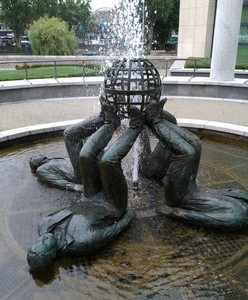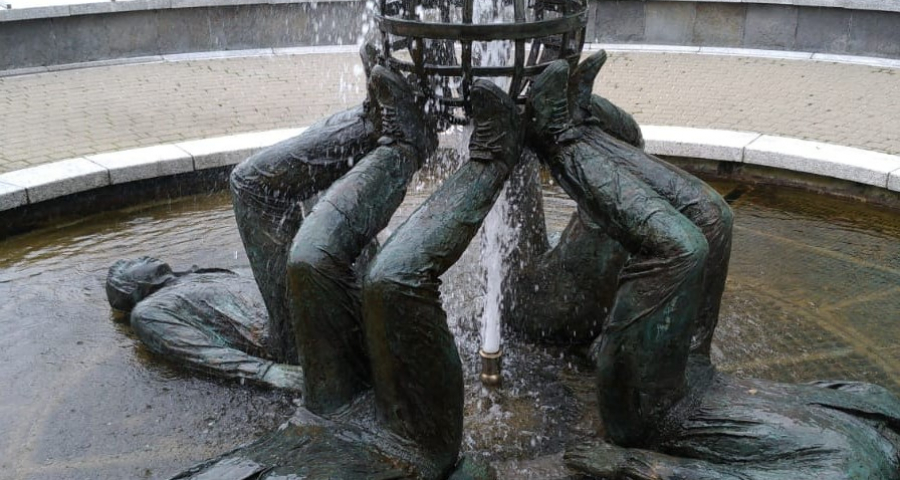Surpluses and misalignments/1 - Infinity is the value that leads beyond fear
by Luigino Bruni
published in Avvenire on 02/09/2018
 “Black Swan logic makes what you don't know far more relevant than what you do know.”
“Black Swan logic makes what you don't know far more relevant than what you do know.”
Nassim N. Taleb The Black Swan
The "black swan" is that highly improbable event with very relevant effects whose arrival could be neither foreseen nor explained on the basis of the facts of the past. The expression comes from the discovery of black swans in Australia, which disproved the thesis that had been considered certain: "all swans are white". In fact, the black swan is the great enemy of companies and organizations, too, because of its potentially devastating effects.
But even if the more or less scientific debate that has developed in recent years highlights almost exclusively the destructive effects, in reality the totally unexpected and surprising events can also represent salvation for organizations and communities. The unexpected can be the greatest gift - we see it every day in our children. In fact, if we look deeply into the dynamics of actual organizations, whether economic or other, we realize that the real big enemy, the evil black swan is the invincible tendency to create rigid management routines built on the observation of the past, and therefore to prevent the understanding of the arrival of great novelties. By looking back, the management guiding today lets us "know" only what we have already known; theirs is a retroactive look that, as in the biblical story of Lot's wife (Genesis 19:26), transforms life into a dead statue of salt. Hence, the really serious danger for organizations does not lie in the existence of black swans but in their management, which is too often wrong.
The most common mistake comes from the fear of the arrival of the evil black swan that leads to hostility towards each swan with not-exactly white coloured feathers. Because of the terror of a black swan, everyone is left in the routine and monotony of a single-coloured world, and beauty and biodiversity are lost. It’s an understandable choice, because if the unexpected event is one of the really bad ones, it can even lead to the destruction of the community by itself.
But it is precisely here that we enter the heart of one of the main paradoxes of communities (and people). The swan with different feathers that can be glimpsed on the horizon could be Satan or the Antichrist, but that strange colour could also be that of Isaiah, Francis and Clare, Teresa of Calcutta or Jesus of Nazareth. We can't know at first glance, nor at the second - often only at the end (that’s where its tremendous and wonderful mystery lies). But if we block all the non-conforming colours in their auroral moment, perhaps we prevent the arrival of the devastating black swan (although we have no guarantee of success), but we certainly prevent the real and good news from coming, ripening and bringing their fruits and essential oils. One of the relational traps that make organizations much less creative, vital and innovative than they could be is in fact the more or less conscious struggle between the management and potential black swans. The former does everything to make the latter return to the routine logic - the sofas so commonly present in the halls of modern organizations are just like beds of Procrustes. Real innovation is linked to people who, to let them act to their full potential, cannot be managed with the typical managerial tools. Today we are finally realizing that vital organizations capable of generating real novelties must renounce the same claim to govern and control their people, because in truly decisive dynamics people are unmanageable, because if they were totally governed they would lose the most innovative component of their creativity. The metaphor of the black swan is therefore a good rhetorical expedient to begin a discussion on the management of real novelties in organizations, people and governance rules.
What we have just pointed out becomes really decisive in the so-called IDO-s, the ideal-driven organisations, those collective realities born around certain people (founders) and moved by ideals other than economic profits (ideals that we have also called charismas or prophetic vocations). IDO-s include spiritual and political movements, religious communities, many NGO-s, cooperatives, and a number of social and civil enterprises of communion. They are not always good and wonderful things, but they are often good and wonderful. In my homeland the first and often only capital consists in the people and their relational assets; all people, but especially those who act on the basis of intrinsic motivations; that is, those members, workers and managers who have not entered their respective organization primarily for economic and financial incentives, but because of an inner call, therefore by "vocation" (using this word, as always, in the most secular and broadest possible sense). IDO-s continue after their foundation only if they are able to attract and retain a nucleus of people who know how to revive the first ideals. If, that is, they succeed in attracting, maintaining, cultivating and flourishing at least one good black swan, which will perhaps be able to revive the heritage passed down by the first generation.
And that’s where the more important kind of reasoning begins.
In the meantime, there is a first fact: many IDO-s are born from black swan phenomena. The first one is the founder him/herself, because perhaps there is nothing more unpredictable, unexpected than the vast impact of the advent of a new charisma on earth (including artistic charismas). Often the founder of a new community is a different swan that has flown away from an original community that, by mistake or by a new vocation, has become too confined a space for its higher and crazier flights.
During the foundation phase the innovative power of the founder is so extraordinary that it contaminates all the other members of the IDO, which gradually becomes a community of swans with the same plumage as the founder’s. The innovative dimension present in many members of the IDO is oriented towards the founder, and all their ideal energies and talents are used in a camouflaging way, to align themselves with the new "colour". This process works out very well, because the members of that community do not feel anything more intimate, sincere, true and proper than wanting to take on the features and tones of the founders.
That’s how the founder's original diversity and their first heterodoxy gradually generate a new kind of orthodoxy, and the founder's innovative colour gradually becomes the only colour for everyone. At the beginning, this operation of mimesis fully satisfies body and soul. But, without wanting or knowing it, this process ends up producing a static situation which is very similar, if not identical, to those realities that the founder and his followers wanted to change at the beginning. And so the heterodoxy generated by a black swan event that had criticized and forced the ancient dogma reproduces a new dogma during the life cycle of the founder that, like all dogmas, fights innovations. This dynamic, well known in the social and organizational sciences, is very often what marks the end of innovative and prophetic experiences, which exhaust their mission when they reach a situation similar to that from which they started.
In addition, IDO-s attract many more potential black swans than other organizations, because ideal motivations, not to mention religious ones, select many excellent people in some dimensions. The IDO-s have always been and continue to be populated by ethically and spiritually extraordinary people. For this reason a person who has received an authentic vocation (and every IDO, to be and to remain one, must host at least one) is potentially a black swan, because they are unique, unrepeatable and non-programmable. Neither they nor anyone else knows what they will become, nobody knows what impact their life will have on those of others: it is a message entrusted to a bottle and the sea that will be read only if and when someone picks it up (an argument that may well be valid for every person that comes into this world). Every vocation is a black swan event - unpredictable, unexpected, and with great effects.
However, in the IDO-s this is more radically present than elsewhere (the reasons for which will be analysed in this series of articles); the management of radically innovative people is particularly difficult, painful and rarely crowned with success. An IDO knows or senses that in every different plumage the killer swan may be hiding, and this legitimate fear often devours the fulfilment of the promise. Because the price of the hope of being able to generate a new authentic prophet is the possibility of generating ten false prophets. This radical fear can be overcome by giving the promise a much higher value than the fear of being killed by a particularly bad false prophet - an infinite value. So the hostility and resistance that every black swan process is met with in every organization are amplified and radicalised in the IDO-s. The existence of a founding charisma/ideal naturally leads IDO-s to be anchored in the past, to give more importance to the beginning than to the eschaton. This looking to the origin is part of the charismatic DNA of the IDO-s, especially those of spiritual and religious nature. The eventual reformer could save them by moving the axis from the past to the future, but this is precisely what the charismatic communities and ideals most fear and fight against. We are inside a typical tragedy - but tragedies are also among the greatest creations of the human genius. Ordinary organizations, as they are often pragmatic and concrete, are more open to the new than IDO-s. On the other hand, IDO-s naturally develop powerful mechanisms to intercept and block the arrival of bad black swans. However, these systems, and this is the point, also block the good ones. Few collective realities are more refractory to the great innovations than IDO-s, because the safeguarding of the heritage of the past is a co-essential element in them (unlike companies, there is no change in the "charisma" or "founder" if the market no longer responds: what to change then?).
This means, on the level of individuals, that those who happen to have, by destiny and call, a different plumage within the community that generated them - and there are many - must become aware that the resistance, hostility, sometimes persecution and slander that they experience, are largely inevitable, because they are all inscribed in the nature of an IDO. They should learn to live with their own surplus and the misalignments that each surplus produces, looking after them with meekness.
This new series of articles will be built around these themes, and we will ask many new questions to IDO-s and their people. These include: what are the typical characteristics of the management of these surpluses in the various phases of the life of the person and the organization? How do they handle surplus as a young person, and how do they do it when they are old? How can we save biodiversity to ensure new life? How can we preserve multi-dimensional vocations today?
We will face these and other vital challenges, even though we know that written and read words are not enough to save us. They can only help us not to stop walking ahead.
download pdf article in pdf (84 KB)







